Neisseria kochii
Introduction
Neisserial strains which exhibited characteristics of both N. gonorrhoeae and N. meningitidis were isolated from the eyes of patients with conjunctivitis in rural Egypt. Strains of this species have been isolated from men with urethritis in Alexandria, Egypt (unpublished data).
The "Egyptian" isolates exhibit characteristics of both N. gonorrhoeae and N. meningitidis (Table 1).
Table 1. Comparison of phenotypic characteristics of N. gonorrhoeae subspecies kochii with those of N. gonorrhoeae and N. meningitidis.
| Characteristic | Similarity to N. gonorrhoeae or N. meningitidis. |
|---|---|
| Colony Morphology | Produces large, pigmented colonies (similar to N. meningitidis). |
| Acid Production | Produces acid from glucose but not maltose (similar to N. gonorrhoeae). |
| Enzyme Substrate Test | Produces prolylaminopeptidase (similar to N. gonorrhoeae); does not produce gamma-glutamylaminopeptidase as does N. meningitidis. |
| Reaction in temperature-sensitive transformation test for N. gonorrhoeae | Gave positive reaction but at a lower frequency than for N. gonorrhoeae (similar to N. gonorrhoeae). |
| Reaction with N. gonorrhoeae-specific monoclonal antibodies | No reaction |
| Reaction with N. meningitidis-specific serotyping reagents | No reaction |
| Requirement for cystine/cysteine for growth on chemically defined (auxotyping) medium | Require cystine/cysteine (similar to N. gonorrhoeae). Note: N. meningitidis strains do not require cystine/cysteine to grow on auxotyping medium |
The "Egyptian" strains have been identified as N. gonorrhoeae subsp. kochii; they are thought to have been the organism described by Koch in 1883 . This subspecies has not been documented in the United States; clinical isolates of this subspecies would be identified as N. gonorrhoeae by biochemical tests but probably would not be identified as N. gonorrhoeae if serological tests were used as the sole diagnostic test.
Table 2. Characteristics of "N. kochii"
| Characteristic | Illustration |
|---|---|
| Gram stain Cell Morphology | Gram-negative diplococcus |
| Colony Morphology | 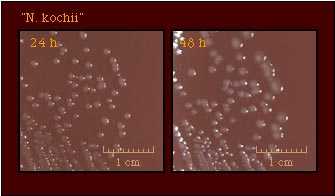 |
| Pigmentation | 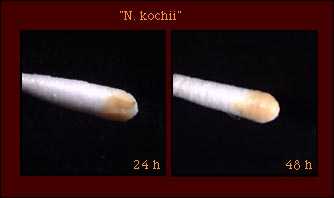 |
| Oxidase Test | 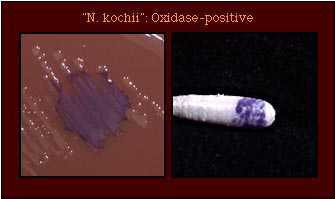 |
| Acid Production |  Acid produced only from Glucose |
| Enzyme Substrate Test | Hydroxyprolylaminopeptidase-positive |
| Nitrate Reduction Test | Nitrate -ve |
Although strains of some organisms do not grow on medium on which polysaccharide is detected, polysaccharide may be detected in the growth inoculated onto the plate. N. gonorrhoeae subspecies kochii does not produce polysaccharide from sucrose. | 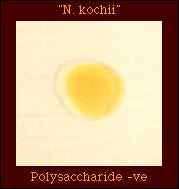 Polysaccharide -ve |
| Production of Deoxyribonuclease (DNase) |  DNase -ve |
| Superoxol Test (Reaction with 30% hydrogen peroxide) | 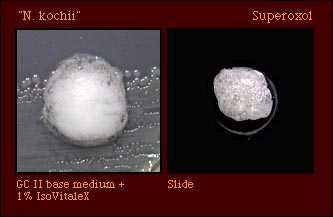 Strains produce a strong (4+) reaction similar to N. gonorrhoeae. |
| Catalase Test (Reaction with 3% hydrogen peroxide) | 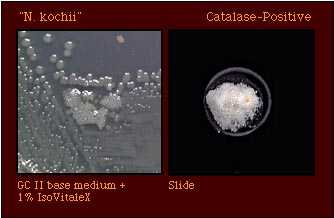 Catalase-positive |
| Colistin Resistance | 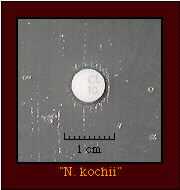 Colistin-resistant |
Neisseria species which may be misidentified as "N. kochii" in acid detection tests
If acid production or enzyme substrate tests are used to identify strains of "N. kochii," these strains will be identified as N. gonorrhoeae. Since strains of this group are classified as N. gonorrhoeae, this is an accurate identification. However, experienced laboratorians will be puzzled by the fact that the colony morphology of these strains is similar to N. meningitidis and, because of this similarity, may be inclined to identify them as maltose-negative strains of N. meningitidis. However, unlike N. meningitidis strains which produce gamma-glutamylaminopeptidase, strains of N. gonorrhoeae subsp. kochii produce hydroxyprolylaminopeptidase.
Depending on the identification test used, several strains of Neisseria and related species may be misidentified as N. gonorrhoeae subsp. kochii; the biochemical characteristics of these species are shown in Table 3.
Table 3. Differential characteristics of Neisseria spp. which produce acid only from glucose.
| Species | Acid from | Gram stain | Enzyme substrate | Nitrate Reduction | Poly- saccharide from Sucrose | DNase | Superoxol | Pigment | Colistin Resistance* | ||||
|---|---|---|---|---|---|---|---|---|---|---|---|---|---|
| G | M | S | F | L | |||||||||
| "N. kochii" | + | - | - | - | - | GND | Hydroxyprolyl- aminopeptidase +ve | - | - | - | Strong (4+) reaction " explosive" | - | R |
| N. gonorrhoeae | + | - | - | - | - | GND | Hydroxyprolyl- aminopeptidase +ve | - | - | - | Strong (4+) reaction " explosive" | - | R |
| Maltose-negative N. meningitidis | + | - | - | - | - | GND | Gammaglutamyl- aminopeptidase +ve | - | - | - | Weak (1+) to strong (4+) reaction | - | R |
| K. denitrificans | + | - | - | - | - | GNR | Hydroxyprolyl- aminopeptidase +ve | + | - | - | - | - | R |
| (N. cinerea) | - | - | - | - | - | GND | Hydroxyprolyl- aminopeptidase +ve | - | - | - | Weak (2+) reaction | - | (R) |
| (M. catarrhalis) | - | - | - | - | - | GND | No reaction | + | - | + | Strong (3+ to 4+) reactions | - | (R) |
Abbreviations: GND, Gram-negative diplococcus; GNR, Gram-negative rod; +, most strains positive; -, most strains negative; R, strains grow well on selective medium for N. gonorrhoeae and/or show no inhibition around a colistin disk (10 micrograms); (R), most strains susceptible, some strains known to be resistant.
Although enzyme substrate tests are intended to be used only for the identification of Neisseria spp. isolated on selective media for N. gonorrhoeae, these tests do provide additional information that may aid in accurately identifying an isolate. These tests should, however, not be used as the primary identification test for strains isolated on nonselective media.
Although enzyme substrate tests are intended to be used only for the identification of Neisseria spp. isolated on selective media for N. gonorrhoeae, isolates of other Neisseria spp. give the same reaction (hydroxyprolylaminopeptidase-positive) in this test as do isolates of N. gonorrhoeae. Thus, additional tests must be performed to differentiate between these species.
Table 4. Supplemental tests which permit differentiation among Neisseria and related species that produce hydroxyprolylaminopeptidase in enzyme substrate tests.
| Species that Produce Hydroxyprolylamino- peptidase | Cellular Elongation* | Acid from | Nitrate Reduction | Polysaccharide from Sucrose | Superoxol | Colistin Resistance | ||||
|---|---|---|---|---|---|---|---|---|---|---|
| G | M | S | F | L | ||||||
| "N. kochii"* | Diplococci | + | - | - | - | - | - | - | Strong (4+) positive " explosive" | R |
| N. gonorrhoeae | Diplococci | + | - | - | - | - | - | - | Strong (4+) positive " explosive" | R |
| K. denitrificans | Rod filaments | + | - | - | - | - | + | - | - | R |
| (N. cinerea) | Diplococci | - | - | - | - | - | - | - | Weak (2+) positive | (R) |
| N. subflava biovar subflava | Diplococci | + | + | - | - | - | - | - | Weak (2+) positive | S |
| N. subflava biovar flava | Diplococci | + | + | - | + | - | - | - | Weak (2+) positive | S |
| N. subflava biovar perflava | Diplococci | + | + | + | + | - | - | + | Weak (2+) positive | (R) |
| N. sicca | Diplococci | + | + | + | + | - | - | + | Weak (2+) positive | S |
| N. mucosa | Diplococci | + | + | + | + | - | + | + | Weak (2+) positive | S |
| (N. flavescens) | Diplococci | - | - | - | - | - | - | + | Weak (2+) positive | R |
Abbreviations: +, most strains positive; -, most strains negative; R, strains grow well on selective medium for N. gonorrhoeae and/or show no inhibition around a colistin disk (10 micrograms); (R), most strains susceptible, some strains known to be resistant; S, strains susceptible, no strains known to be resistant.
*Strains of N. gonorrhoeae subsp. kochii have colonies that resemble N. meningitidis but do not type with meningococcal serotyping tests.
References
Bovre K. 1984. Family VIII. Neisseriaceae Prevot, p. 288-309. In N. R. Krieg (ed.). Manual of Systematic Bacteriology, vol. 1. The Williams & Wilkins co., Baltimore.
Knapp JS. Historical perspectives and identification of Neisseria and related species. Clin Microbiol Rev 1988;1:415-431.
Knapp JS, Rice RJ. Neisseria and Branhamella. In. Murray PR, Baron EJ, Pfaller MA, Tenover FC, Yolken RH. (ed.). Manual of Clinical Microbiology. 6th ed. American Society for Microbiology, Washington D. C, 1995.
Mazloum H, Totten PA, Dawson CR, Falkow S, James JF, Knapp JS, Koomey JM, Lammel CJ, Peters D, Schachter J, Tang WS, Vedros NA. Unusual Neisseria isolated from conjunctival cultures in rural Egypt. J Infect Dis 1986;154:212-224.
Vedros NA. 1984. Genus I. Neisseria Trevisan 1885, 105AL, p. 290-296. In N. R. Krieg (ed.). Bergey's Manual of Systematic Bacteriology, vol. 1. The Williams & Wilkins Co., Baltimore.
- Page last reviewed: March 31, 2017
- Page last updated: October 17, 2008
- Content source:


 ShareCompartir
ShareCompartir